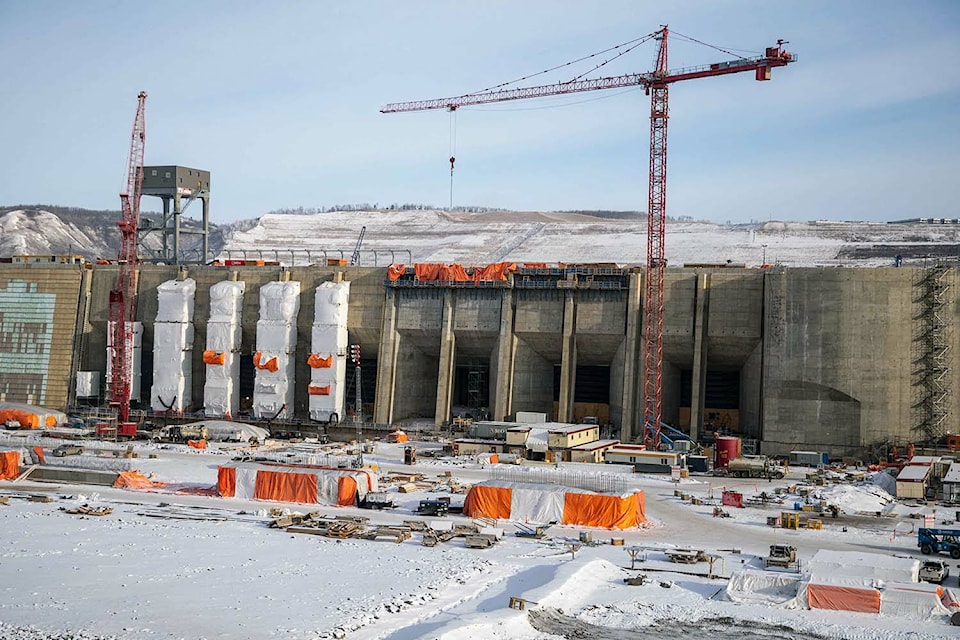Opposition critic for energy and mine projects in B.C. is calling out the Eby government for proposed changes to Site C in northern B.C. that they argue reflects the government’s mismanagement of the project.
“(This) amendment appears to be an effort to save additional debt on a project that is already $8 billion well over the original budget when the NDP first took over in 2017,” Fort St. John MLA Dan Davies and Kootenay East MLA Tom Shypitka said in a joint statement. Shypitka is opposition critic for the project.
Construction debris large enough to cover 28 soccer fields could remain on the bottom of the Peace River in northeastern B.C. if a provincial agency were to approve changes to BC Hydro’s Site C project.
In a submission to the Environmental Assessment Office, BC Hydro says leaving the debris behind could actually be better for the environment once an 80-kilometre stretch of the river’s valley floods to create hydroelectricity.
Up to 45 structures, including giant concrete anchors, causeways, concrete abutments and a barge pad could remain behind.
The public submission period for feedback closed April 22. Environment George Heyman said it is “not abnormal to make an application for an amendment,” adding that it would be “reviewed carefully.”
But both Davies and Shypitka expressed concern about the environmental and economic aspects of the application.
RELATED: BC Hydro applies to leave some Site C construction debris to be flooded over
“It was always understood that BC Hydro would remove these structures as soon as they are no longer required and this proposal to leave pieces of causeways, gravel pads, concrete abutments, concrete anchors, and pieces from diversion channels in the reservoir is particularly worrying considering we don’t know the long-term impacts they will have on the river,” they said.
Davies and Shypitka added that the project would have been providing clean electricity to B.C. if the NDP hadn’t completely mismanaged the project, because it was on time and on-budget when the then-Horgan government took it over in 2017.
The project launched by BC United (then the BC Liberals) was exempt from review with costs escalating from $6 billion in 2010 to $8.8 billion in 2014. New Democrats ordered a review of the project in 2017 but pushed ahead even after the cost had escalated to $10.7 billion, stating it was far too advanced to stop after construction had started in July 2015.
Its current price tag sits at $16 billion with completion scheduled for 2025.
Assessments by both the B.C. Utilities Commission and independent sources such as C.D. Howe Institute and Oxford University found that the economic case for the project was never strong.
C.D. Howe Institute actually argued that former premier John Horgan would have been better off to cancel the project than continue to sink money into Site C, whose economics already did not make sense when the BC Liberals pushed it ahead.
Horgan had justified completing Site C by saying that government “would not ask British Columbians to take on $4 billion in debt with nothing in return for the people” of B.C.
“However, careful economic analysis suggests that BC ratepayers may, in fact, end up paying more by the project continuing than they would if they simply paid off the debt already incurred and pursued an alternative path,” C.D. Howe said.
The Ministry of Energy, Mines and Low Carbon Innovation disagreed in a statement with the comments from BC United.
“The amendment was not filed as a way to save costs on the Site C project,” it read. “It is intended to ensure that fish habitat is protected.”
The statement added structures that remain in the reservoir will undergo assessment by a qualified environmental professional to confirm that they won’t pose a risk to the environment now or in future.
“The structures will be sufficiently below the operating level of the reservoir to prevent potential risks to boaters,” it added.
@wolfgangdepner
wolfgang.depner@blackpress.ca
Like us on Facebook and follow us on Twitter.
